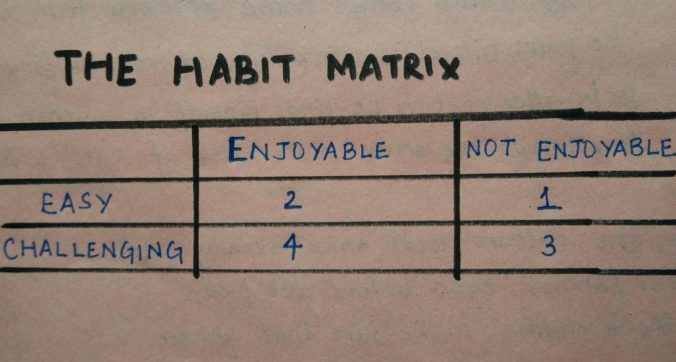Today, I would like to share an idea about designing a positive change in your lifestyle that will stick. All of us have experienced how difficult it is to sustain a good habit. But what could be the reason that this journey is met with failure so often! Shouldn’t our actions naturally gravitate towards our own betterment? One of the reasons for this constant stumbling on the journey towards positive change is that we do not find the right mix of the level of challenge and our level of enjoyment at the pertinent time.
Let me illustrate this with the matrix pictured in the beginning :
As you can see in the matrix any habit will fall into the following four categories.
A habit that is :
1) Easy to follow but that you don’t enjoy so much
2) Easy to follow that you enjoy doing
3) Challenging to follow that you don’t enjoy
4) Challenging to follow that you enjoy
Let’s take a habit to make things clearer. Say a person wishes to start running every day. His goal is to be able to run for 5 kilometers after 90 days of training. Now, where does he start? He doesn’t even go for a walk as yet!
A logical flow to follow according to the matrix would be:
1) Start walking every day for half an hour. It is a goal that’s easy to meet. He might not enjoy it at first, but within a week, he will start liking it. The outdoors have that power over every human being.
2) Once he is comfortable with the walking, his body will naturally want to take it a step further to jogging. The happy hormones and sweat will make sure he enjoys the activity. His stamina will boost and in a couple of weeks he will be ready to take the next step.
3) Running would still seem difficult, but in the interest of fulfilling his goal, he will have to take the next step. He might not enjoy the challenge of running at first, but he understands that he will only emerge stronger from here on. In a couple of weeks, running will become natural to him.
4) Eventually, since he can see the end goal in sight, he has all the motivation to keep training. He realizes that he has come a long way from where he had started. Even though it is challenging to train every day, he will run happily.
If he follows this matrix guided approach, making a change will be easy.
Let us take another example. Say you want to write stories. But you have not written one in your life so far. Where do you start?
1) Start with writing one line a day. It won’t be enjoyable at first but once you get past the inertia it will become natural to write. (Easy task, Not enjoyable at first)
2) Next, when you’re comfortable writing one line a day, make use of the momentum and write one paragraph a day. Since the wheels are in motion and you’re creating something new, you will enjoy the process.
(Easy task, Enjoyable)
3) Once you’re comfortable writing a paragraph, challenge yourself to write one full page. Write about the synopsis of the story on one day, write a page of character sketch the next day. It will be challenging at first and you might not enjoy it initially. But soon, you will realize that the exercise enlivens your imagination and you come up with better ideas as a result. (Challenging task, Not enjoyable at first)
4) The next logical step is to piece together the story with the framework you’ve built in step three. You will have the momentum and the direction to finish the story. The act of creation becomes easier because of your homework. Writing the story will become an enjoyable process. (Challenging task, Enjoyable)
The matrix forms a good framework to design a positive change. The level of challenge and the level of enjoyment are designed such that they are pertinent to the stage of change, in sync with the level of motivation an individual has.
Step one helps you overcome inertia, step two helps in building momentum, step three in challenging yourself and step four helps in finding flow.
The next time you’re seeking to develop a positive habit in pursuit of a personal goal, design your plan with the reference of this matrix.
The change is much likely to stick.
Good luck!

Leave a Reply